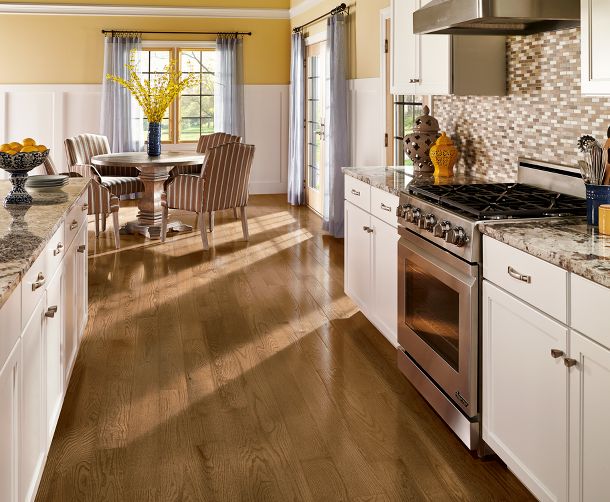Hardwood Flooring 101
If you’re looking to add warmth and beauty to your home, nothing compares to genuine hardwood flooring. Engineered and solid hardwood floors are both made from 100% real wood, but there are significant differences in their overall construction.
Engineered wood floors behave a little differently than solid plank floors do. They tend to be easier to install and are usually less expensive than solid hardwood.
However, not all wood floors are created equal. Depending on the type or species of wood the flooring is made from will determine what type of performance qualities it has. Understanding these differences will go a long way to help you choose the wood floor that’s right for your home.

Engineered Hardwood vs. Solid Hardwood
Solid hardwood floors are just that — they’re made from solid wood. Each board of solid hardwood flooring is made from a single piece of hardwood that’s about 3/4 of an inch thick. Because it’s so thick it can be sanded down and refinished for however long the flooring is in the house.
Engineered hardwood is a versatile and resilient flooring option that can be installed in most areas of your home. Made of genuine wood, this flooring gives your home an updated look and feel. Engineered hardwood is made of a core of hardwood or plywood with a layer of hardwood veneer affixed to the top surface. It’s more resistant to moisture and heat compared to solid hardwood.
Where Can I Install Hardwood Floors?
Solid hardwood expands and contracts in reaction to changes in moisture and temperature, so solid wood floors are only recommended for rooms at ground level or above.
The unique construction of engineered wood creates a structure that is less likely to buckle, gap, or react to fluctuations in humidity and temperature. You can install engineered flooring on any level, including below ground. It’s a great choice for finished basements and bathrooms.
Solid vs. Engineered Performance
Both solid and engineered hardwood floors are designed for beauty and durability. Their tough surface can stand up to active homes. However, both solid and engineered hardwood flooring have different performance attributes.
Solid wood flooring is permanently nailed to the subfloor. Because of expansion and contraction issues, installers will normally leave a gap between the wall and the floor to accommodate swelling. This type of flooring should only be installed in parts of the home above grade and only over plywood, wood or oriented strand board subfloors.
Engineered floors have enhanced stability, which provides slightly more resistance to everyday wear- and-tear and also to buckling or rippling. Solid hardwood floors are more prone to shrinking or expanding based on humidity levels.
Engineered wood floors can be more resistant to moisture and offer a bit more stability than solid hardwood. While no wood product can tolerate water laying on it, the increased moisture levels over concrete aren’t a problem for most engineered wood floors. Unlike solid hardwood, engineered hardwood can go over concrete under the right conditions.
Refinishing Hardwood Floor
Both engineered and solid hardwood flooring can be refinished. Solid hardwood can be refinished up to 10 times depending on the board thickness. Engineered boards requires less refinishing over its lifetime – typically only one or two times.
Refinishing your hardwood floors can be a DIY project, but it requires some skill and a bit of patience. Equipment rental can range between $200-$300 dollars. If you’re not completely confident in your skill level, you may want to consider hiring a professional.
Hardwood Flooring Costs
The cost of solid vs. engineered hardwood is typically dependent on the quality and species of the wood. Exotic or highly-coveted hardwood, such as maple, may be more expensive than engineered flooring. For more common hardwoods, solid wood flooring may be cheaper overall, although it will take longer to install.
The layers in the buildup underneath the top layer of engineered hardwood also play a role in the final price. There can be anywhere between three and 12 layers of plywood and unfinished white wood, depending on the thickness and quality of the finished product. Armstrong’s price estimator is a helpful tool to get an estimate for the cost of buying and installing a hardwood floor.
